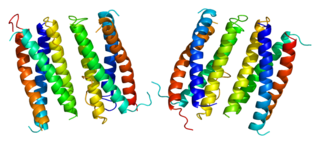Cytokine receptor-like factor 1 is a protein that in humans is encoded by the CRLF1 gene. [5] [6]
Cytokine receptor-like factor 1 is a protein that in humans is encoded by the CRLF1 gene. [5] [6]
This gene encodes a member of the cytokine type I receptor family. The protein forms a secreted complex with cardiotrophin-like cytokine factor 1 and acts on cells expressing ciliary neurotrophic factor receptors. The complex can promote survival of neuronal cells. [6]
Mutations in this gene are associated with two conditions, both rare:
It is unknown whether the two conditions are distinct clinical entities or a single clinical entity with variable expressions. [7] Other characteristic features in CRLF1 mutation include marfanoid habitus with progressive kyphoscoliosis and craniofacial characteristics including dolichocephaly, a slender face with poor expression, a nose with hypoplastic nares, malar hypoplasia and prognathism. [7]

Treacle protein is a protein that in humans is encoded by the TCOF1 gene.

Interferon regulatory factor 6 also known as IRF6 is a protein that in humans is encoded by the IRF6 gene.

Tyrosine-protein kinase transmembrane receptor ROR2, also known as neurotrophic tyrosine kinase, receptor-related 2, is a protein that in humans is encoded by the ROR2 gene located on position 9 of the long arm of chromosome 9. This protein is responsible for aspects of bone and cartilage growth. It is involved in Robinow syndrome and autosomal dominant brachydactyly type B. ROR2 is a member of the receptor tyrosine kinase-like orphan receptor (ROR) family.

Ciliary neurotrophic factor is a protein that in humans is encoded by the CNTF gene.

Interleukin-31 (IL-31) is a protein that in humans is encoded by the IL31 gene that resides on chromosome 12. IL-31 is an inflammatory cytokine that helps trigger cell-mediated immunity against pathogens. It has also been identified as a major player in a number of chronic inflammatory diseases, including atopic dermatitis.

Fibroblast growth factor receptor 2 (FGFR2) also known as CD332 is a protein that in humans is encoded by the FGFR2 gene residing on chromosome 10. FGFR2 is a receptor for fibroblast growth factor.

LIFR also known as CD118, is a subunit of a receptor for leukemia inhibitory factor.

Interleukin 6 receptor (IL6R) also known as CD126 is a type I cytokine receptor.

ADGRV1, also known as G protein-coupled receptor 98 (GPR98) or Very Large G-protein coupled receptor 1 (VLGR1), is a protein that in humans is encoded by the GPR98 gene. Several alternatively spliced transcripts have been described.

Interleukin 11 receptor, alpha subunit is a subunit of the interleukin 11 receptor. IL11RA is its human gene.

Centrosomal protein of 290 kDa is a protein that in humans is encoded by the CEP290 gene. CEP290 is located on the Q arm of chromosome 12.

The human gene UBR1 encodes the enzyme ubiquitin-protein ligase E3 component n-recognin 1.

Acetylcholine receptor subunit beta is a protein that in humans is encoded by the CHRNB1 gene.

Cardiotrophin-like cytokine factor 1 (CLCF1), also known as Novel Neurotrophin-1 (NNT-1) or B cell-stimulating factor-3 (BSF-3), is a protein that in humans is encoded by the CLCF1 gene.

T-box transcription factor TBX22 is a protein that in humans is encoded by the TBX22 gene.

Bardet–Biedl syndrome 7 is a protein that in humans is encoded by the BBS7 gene.

Transmembrane protein 216 is a protein in humans that is encoded by the TMEM216 gene.

ADP-ribosylation factor-like protein 13B (ARL13B), also known as ADP-ribosylation factor-like protein 2-like 1, is a protein that in humans is encoded by the ARL13B gene.

FYVE, RhoGEF and PH domain-containing protein 2 (FGD2), also known as zinc finger FYVE domain-containing protein 4 (ZFYVE4), is a protein that in humans is encoded by the FGD2 gene.

Cytokine receptor-like factor 3 is a protein that in humans is encoded by the CRLF3 gene.
This article incorporates text from the United States National Library of Medicine, which is in the public domain.